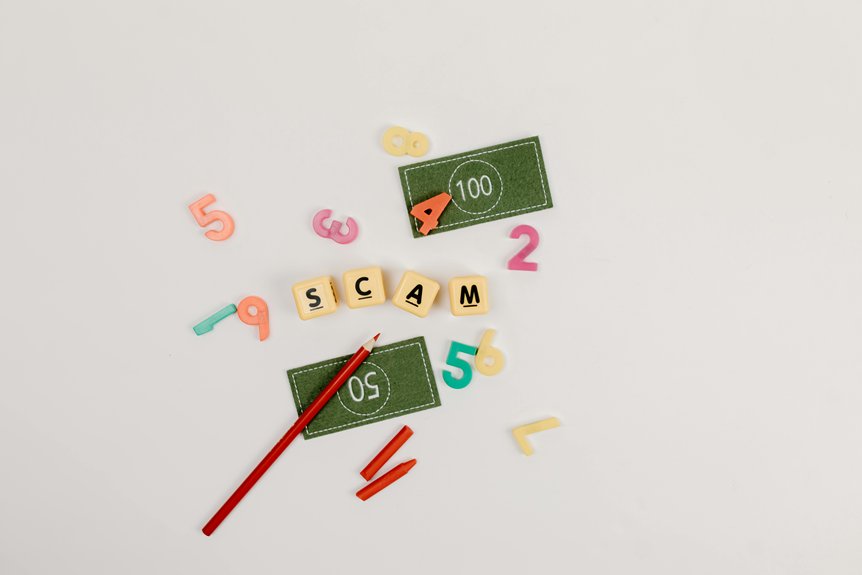As a new inventor, you face the risk of falling victim to scams in a competitive industry. It’s essential to stay vigilant and informed about common warning signs, so you don’t compromise your ideas or finances. The right steps can help you protect your work, but knowing which ones can be tricky. Wondering how to spot the red flags and secure your invention? Keep going to find out.
Recognize Common Signs of Scams in the Invention Industry
To protect yourself as a new inventor, it’s essential to recognize the common signs of scams in the invention industry. Watch out for red flag indicators like promises of guaranteed success or quick profits, which are often scam tactics.
Be cautious of firms that demand upfront fees without providing clear explanations or legitimate credentials. If someone pressures you to sign contracts immediately or asks for sensitive personal information, it’s a warning sign.
Trust your instincts and do thorough research. Recognizing these red flags helps you avoid falling for scam tactics that could jeopardize your invention and financial security.
Conduct Thorough Research on Patent and Licensing Firms
Before entrusting a patent or licensing firm with your invention, it’s crucial to thoroughly research their background and reputation. Conduct patent research to verify their credentials, track record, and client reviews. You can also inquire about their experience with patent application process and whether they have successfully secured patents for other inventors. Look for licensing strategies they’ve successfully implemented and confirm they align with your goals. Beware of firms with vague claims or those unwilling to provide references. A reputable firm will be transparent about their experience and methods. Doing your due diligence helps you avoid scams and partners with genuine expertise.
Protect Your Ideas With Proper Documentation and Confidentiality Agreements
Once you’ve researched and chosen a reputable patent or licensing firm, safeguarding your ideas becomes your next priority. You should create thorough idea documentation, including sketches, descriptions, and dates, to establish a clear record of your invention’s development.
Additionally, always use confidentiality agreements when sharing your ideas with others, such as potential partners or manufacturers. These agreements legally protect your intellectual property and prevent unauthorized use or theft.
Proper idea documentation combined with signed confidentiality agreements helps you prove ownership and deters scammers who might try to steal or exploit your invention. Protecting your ideas early on is essential to avoid being scammed or losing control.
Be Cautious With Upfront Fees and Payment Requests
Be cautious when you encounter requests for large upfront fees or unexpected payment demands. Scammers often ask for upfront fees to cover services like patent filings or marketing, but reputable companies rarely require full payment before delivering results.
Always question payment requests that seem excessive or aren’t transparently explained. Research the company’s reputation beforehand, and never feel pressured into paying large sums without clear, written agreements.
Verify the Credentials and Reputation of Potential Partners
To avoid falling for scams, you need to thoroughly verify the credentials and reputation of any potential partners. Conduct credential verification by checking their professional backgrounds, certifications, and references.
A reputation assessment involves researching online reviews, industry standing, and past client experiences. Look for consistent positive feedback and transparency in their dealings.
Beware of partners who are unresponsive or unwilling to provide verifiable credentials. Trust your instincts and ask for proof of legitimacy.
Taking these steps helps guarantee you’re working with reputable, credible individuals or companies, reducing your risk of being scammed and protecting your invention journey.
Understand the Patent Process and Your Rights as an Inventor
Understanding the patent process is essential for protecting your invention and asserting your rights as an inventor. When you file a patent application, you’re taking a critical step to secure exclusive rights and prevent others from copying your idea.
Knowing the process helps you navigate patent laws, deadlines, and requirements effectively. Your invention rights are safeguarded once your patent is granted, giving you legal authority over your creation.
Avoid High-Pressure Sales Tactics and “Too Good to Be True” Offers
High-pressure sales tactics and “too good to be true” offers are common tricks used by unscrupulous individuals targeting new inventors. They use aggressive sales tactics to rush you into decisions, making false promises about guaranteed success, quick royalties, or exclusive rights.
If someone pressures you to sign contracts immediately or promises impossible results, take a step back. Legitimate opportunities don’t rely on false promises or high-pressure approaches.
Always verify the claims, ask for written information, and don’t let fear or excitement cloud your judgment. Protect yourself by remaining cautious and questioning offers that seem too perfect or come with aggressive sales tactics.
Seek Advice From Trusted Mentors and Inventor Communities
Seeking advice from trusted mentors and inventor communities can provide invaluable guidance and help you avoid costly mistakes. Mentorship benefits include insider knowledge, honest feedback, and proven strategies to navigate the invention process safely.
Community networking connects you with experienced inventors who understand the challenges and scams you might encounter. By engaging with these groups, you gain support, learn from others’ experiences, and build trusted relationships.
This collective wisdom helps you spot red flags and make informed decisions, reducing your risk of falling for scams. Remember, a strong network can be your best defense as you bring your invention to life.
Conclusion
By staying vigilant and doing thorough research, you can protect your ideas and avoid scams. Trust reputable firms, never rush into agreements, and always keep your documents secure. Remember, if something feels off or too good to be true, it probably is. Seek advice from trusted mentors and communities to guide you. With careful steps, you’ll navigate the invention world confidently and safeguard your innovations from potential scams. To learn more on how to bring your idea or invention to market, visit us online at Inventors IPO.

